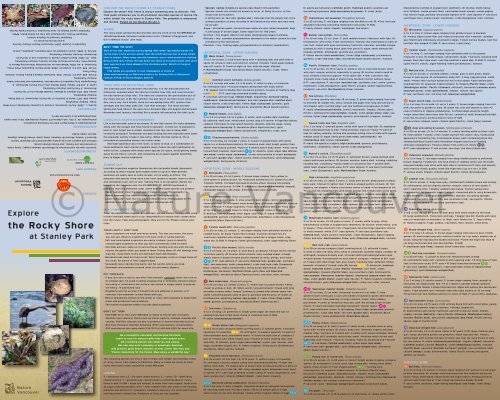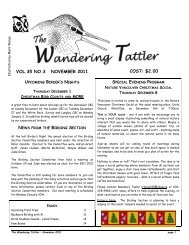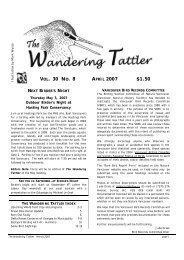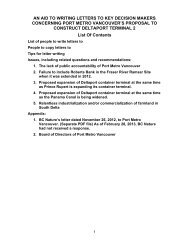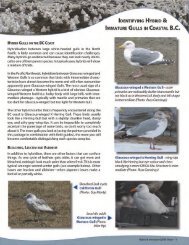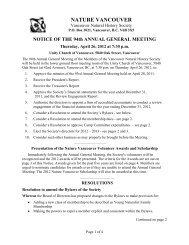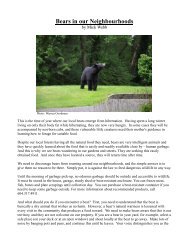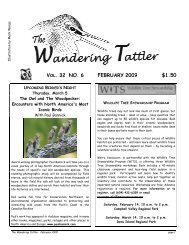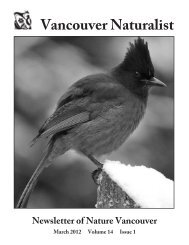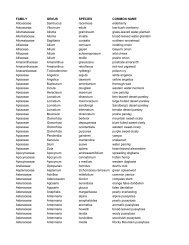Intertidal Pamphlet - Nature Vancouver
Intertidal Pamphlet - Nature Vancouver
Intertidal Pamphlet - Nature Vancouver
Create successful ePaper yourself
Turn your PDF publications into a flip-book with our unique Google optimized e-Paper software.
Copyright © October 2009, <strong>Vancouver</strong> Natural History Society<br />
www.naturevancouver.ca<br />
<strong>Pamphlet</strong> Concept by Daphne Solecki.<br />
<strong>Pamphlet</strong> Project Coordination and Text by Sheila Byers, RPBio.<br />
<strong>Pamphlet</strong> Layout Design by Jana Fernandes, Creative Candy Design.<br />
REFERENCES<br />
Druehl, L.. 2000. Pacific Seaweeds. A Guide to Common Seaweeds of the West<br />
Coast. Harbour Publishing.<br />
Harbo, R.M. 1997. Shells & Shellfish of the Pacific Northwest. A Field Guide.<br />
Harbour Publishing.<br />
Harbo, R.M. 1999. Whelks to Whales. Coastal Marine Life of the Pacific<br />
Northwest. A Field Guide. Harbour Publishing.<br />
Lamb, A. and B.P. Hanby. 2005. Marine Life of the Pacific Northwest. A<br />
Photographic Encyclopedia of Invertebrates, Seaweeds and Selected Fishes.<br />
Harbour Publishing.<br />
O’Clair, R.M. and C.E. O’Clair. 1998. Southeast Alaska’s Rocky Shores. Animals.<br />
Plant Press.<br />
O’Clair, R.M. and S.C. Lindstrom. 2000. North Pacific Seaweeds. Plant Press.<br />
Parkinson, A. ed. 2006. Wilderness on the Doorstep. Discovering <strong>Nature</strong> in<br />
Stanley Park. <strong>Vancouver</strong> Natural History Society. Harbour Publishing.<br />
Sept, J.D. 2009. Beachcomber’s Guide to Seashore Life in the Pacific<br />
Northwest. Revised. Harbour Publishing.<br />
Snively, G. 2006. www.ruralobserver.com/seashore_etiquette_article<br />
<strong>Nature</strong><br />
<strong>Vancouver</strong><br />
EXPLORE THE ROCKY SHORE AT STANLEY PARK<br />
Explore the shore? YES! There is always something new to discover. This<br />
field guide introduces you to 40 prominent intertidal species of marine life<br />
which inhabit the rocky shore in Stanley Park. The pamphlet is waterproof<br />
and durable. Please do not discard. Re-use it.<br />
WHERE<br />
The rocky point jutting into Burrard Inlet directly north of the SS EMPEROR OF<br />
JAPAN figurehead, between Lumberman’s Arch, Children’s Playground, and<br />
Girl in Wetsuit statue. (See map).<br />
BEST TIME TO VISIT<br />
Visit at low tide, especially during spring tides when fascinating marine life<br />
can be seen. Arrive an hour earlier than the predicted low tide to allow ample<br />
time to explore. Wear snug, non-slip footwear; sun or wind protective clothing.<br />
Bring a hand lens. Follow the tide down the shore to its lowest point then work<br />
your way back up. Keep ahead of the incoming water. Watch for large or<br />
rogue waves.<br />
Tide tables are available in local newspapers or online at<br />
www.waterlevels.gc.ca. Reference source for Stanley Park is <strong>Vancouver</strong><br />
(Station #7735) in Pacific Region, Zone 10.<br />
- Species’ names in bold are species described in this pamphlet.<br />
- Species’ names not in bold are known to occur, or likely to occur, at this<br />
locale (not all inclusive).<br />
- A listing such as ‘sea stars (purple star)’ indicates that the purple star is the<br />
primary predator or prey recorded in the literature but other sea stars may<br />
be as well.<br />
Algae = all marine green, red and brown algae are also called seaweeds. Kelp<br />
is one group of brown algae. Some algae live for 700 years.<br />
Detritus = fine organic debris from dead, disintegrated algae or animals.<br />
Diatoms = tiny, common phytoplankton abundant in the water column but also<br />
prevalent on the sea bottom.<br />
Plankton = tiny, floating algae (phytoplankton) or animals (zooplankton).<br />
INTERTIDAL ZONE - UPPER SUBZONE<br />
1 Mask limpet, Tectura persona<br />
S: to 5 cm across. C: blue-brown-grey with >radiating light and dark lines or<br />
spots. ID: univalve: shell oval and thin, smooth, inflated; >shell peak hooked,<br />
way off-centre. D: feeds at night on fine, delicate algae, diatoms.<br />
P: Northwestern Crow, shorebirds (Black Oystercatcher), crabs, fishes<br />
(clingfishes).<br />
D: adults eat barnacles (common acorn, thatched acorn); juveniles eat<br />
encrusting bryozoans (kelp-encrusting bryozoan). P: crabs (kelp).<br />
14 Filamentous red seaweed, Pterosiphonia bipinnata<br />
S: to 25 cm long. C: red algae ranging from blackish to red. ID: >fine, intricate,<br />
abundant branches; branching flattened in one plane. D-SUN.<br />
P: likely chitons, snails, limpets, amphipods, and others.<br />
15 Banner sea-nymph, Nereis vexillosa<br />
S: to 30 cm long. LS: to 1 year. C: dark reddish-brown; iridescent with light. ID:<br />
bristleworm: with many >feet and bristles; >banner-like extensions on each of<br />
rear feet; >head with eyes and sensory tentacles; muscular, eversible tongue<br />
(proboscis) with 2 strong black jaws that pinch! D: algae, small animals like<br />
isopods (gribble), amphipods, juvenile sea cucumbers.<br />
P: ribbon worms (mud nemertean), fishes (high cockscomb, pricklebacks,<br />
gunnels), crabs (red rock crab), shorebirds (Black Oystercatcher), humans.<br />
16 Pacific littleneck clam, Protothaca staminea<br />
S: to 13 cm across. LS: 14-16 years. C: white or tan to chocolate brown; often<br />
with dark, angular patterns, especially in young. ID: bivalve: shells round to<br />
oval, inflated; latticed sculpture: >fine radial ribs, >finer concentric ribs;<br />
>growth lines; inside edge of shells finely toothed; interior without colour.<br />
D-FF: uses siphons. P: sea stars (mottled star, sunflower star), snails (Lewis’s<br />
moonsnail), crabs (Dungeness), giant Pacific octopus, siphon-nipping fishes<br />
(sculpins), sea otter, Northwestern Crow, humans.<br />
blackened by sulfides in oxygen-poor sediments. ID: bivalve: shells heavy,<br />
oval, inflated, >wide growth lines; >protruded lower margin; >wide-gaping<br />
rear end for huge, partially retractable siphons. D-FF: uses siphons. P: sea stars<br />
(sunflower star), snails (Lewis’ moonsnail), crabs (Dungeness crab), humans.<br />
INTERTIDAL ZONE - LOWER SUBZONE<br />
27 Wireweed, Sargassum muticum<br />
S: to 2 m long. C: brown algae ranging from golden brown to blackish.<br />
ID: >many stipes (stem-like) and >lateral branches with >smooth, rounded<br />
gas-filled floats individually attached to stipes; >small narrow blades; root-like<br />
holdfast disk-shaped. D-SUN. P: sea urchins, crabs (kelp).<br />
28 Turkish towel, Chondracanthus exasperatus<br />
S: to 1 m long. C: red algae ranging from yellowish pink to rich purple;<br />
iridescent if wet. ID: blade simple, unbranched, tough, >surfaces carpeted with<br />
bumps; stem-like stipe short; root-like holdfast a small disk. D-SUN. P: chitons<br />
(giant Pacific chiton), algae-nibbling fishes (pricklebacks), humans.<br />
29 Mottled star, Evasterias troschelii<br />
S: to 60 cm across. C: variable: pinkish, orange, pale to dark green, bluish,<br />
brown or pale purple. ID: echinoderm: body stiff, 5 long, tapered arms, >disk<br />
small; >many short surface spines but not in star shape; >pale yellow pore<br />
(madreporite) for seawater intake/exhaust. D: mussels (Pacific blue), clams<br />
(Washington butter, Pacific littleneck, softshell), barnacles (common acorn,<br />
thatched acorn), snails (periwinkles), limpets, chitons, sea squirts.<br />
P: few; sunflower star, red king crab, Glaucous-winged Gull.<br />
2 a Common acorn barnacle, Balanus glandula<br />
S: to 2.2 cm high and wide. LS: 8-10 years. C: white to grey, or brownish.<br />
TIDES AND THE INTERTIDAL ZONE<br />
ID: arthropod: hard, >volcano-shaped casing hides soft body within.<br />
The intertidal zone lies between land and sea. It is the area between the<br />
>‘M’-shaped lock to double-door enclosure protects >6 pairs of feathery legs<br />
tidemarks, exposed when the tide has receded (low tide) and covered when<br />
(cirri) 2 b . D-FF: uses legs extended outside casing.<br />
the tide advances (high tide). The tides are caused by the gravitational pull of<br />
P: univalves and sea slugs (ribbed limpet, dogwinkles, barnacle-eating<br />
17 Sea lettuce, Ulva lactuca<br />
the moon and sun: in BC the rhythmic rise and fall of the tide occurs twice a<br />
nudibranch, checkered periwinkle), sea stars (purple star, mottled star), S: to 1 m long (usually less than 30 cm long). C: green algae ranging from pale<br />
30<br />
day, every day. Each month, there are two spring tides (20% greater than<br />
Sugar wrack kelp, Saccharina latissima<br />
ribbon worms, crabs (red rock), fishes (high cockscomb, gunnels), gulls<br />
to emerald. ID: blades flat, shiny, smooth and paper thin; long and narrow or<br />
average) and two neap tides (20% less than average). The most extreme<br />
S: to 3 m long, 18 cm wide. LS: up to 3 years. C: brown algae ranging from rich<br />
(Glaucous-winged Gull), diving ducks, shorebirds (Black Oystercatcher). fan-shaped, with >ruffled edge; root-like holdfast inconspicuous. D-SUN.<br />
spring and neap tides of the year occur between May and August and between<br />
milk chocolate to golden to wine. ID: blade flat, thin and smooth or with >2<br />
P: snails (checkered periwinkle, Lewis’s moonsnail), limpets, chitons (giant<br />
November and January. <strong>Intertidal</strong> life is greatly influenced by the tidal cycle.<br />
rows of blisters or ripples (undulations), >ruffled edges along its length;<br />
3 Ribbed limpet, Lottia digitalis<br />
Pacific), bristleworms (sea-nymphs), isopods, crabs (green shore crab), sea<br />
>stipe (stem-like) short (less than 20 cm), cylindrical; multi-branched holdfast<br />
S: to 3.5 cm across. LS: to 6 years. C: white, with variable dark markings. urchins, fishes (high cockscomb, gunnels, pricklebacks, sculpins), humans.<br />
(root-like structure) anchors kelp to rocks. D-SUN.<br />
LIVING IN A HARSH ENVIRONMENT<br />
ID: univalve: shell oval, >shell peak curved, way off-centre; >fingerlike ribbing<br />
P: sea urchins, limpets, snails, chitons (giant Pacific), crabs (kelp); humans.<br />
Life in the intertidal zone is not simple. At low tide marine life lacks seawater, radiates from peak. D: blue-green bacteria, diatoms, delicate algae, newly 18 Square-tooth sea flea, Amphithoe valida<br />
along with the oxygen and food found in seawater. It dries out, is exposed to settled acorn barnacles. P: shorebirds (Black Oystercatcher), gulls<br />
S: to 3 cm long. C: emerald green; varies with type of algal diet. ID: amphipod:<br />
31 a Kelp-encrusting bryozoan, Membranipora serrilamella<br />
heat or cold, bright sun or shade, moisture from fog, rain or snow AND -<br />
(Glaucous-winged Gull), fishes (surfperches, clingfishes), crabs, mice.<br />
body compressed side to side; >long antennae, eyes on >head; >7 pairs of<br />
S: to 20 cm across. LS: to 3-4 months. C: colony forming white to silver crust.<br />
terrestrial predators! Freshwater streams flowing into the intertidal zone lower<br />
legs for eating, walking, turning and jumping; eating claw of male with square<br />
ID: moss animal >colony: a thin, single-layered flat cluster; lacy, honeycomb<br />
the seawater salinity (make it less salty). When the tide comes in, life is<br />
4 a Checkered periwinkle, Littorina scutulata<br />
median tooth. D: algae, likely green (sea moss, sea lettuces), red<br />
appearance formed by tiny >rectangular boxes, each containing polyp-like<br />
refreshed but pounding waves can create chaos.<br />
S: to 1.9 cm long. LS: at least 7 years. C: brown or purple/black with white (filamentous red), brown (rockweed).<br />
feeding individual (zooid) with horseshoe-shaped structure of feeding<br />
<strong>Intertidal</strong> substrata vary from rocks, to sand, to mud, or a combination of spots in a >checkerboard pattern. ID: univalve snail: shell height greater than P: many fish species (sculpins, high cockscomb, gunnels, pricklebacks,<br />
tentacles (lophophore); >boxes radiate from centre of colony 31 b .<br />
these sediments. Each marine organism must choose the right substratum on width; >tip sharply pointed; >spire of 4 whorls above body whorl; >thin, horny snailfishes, clingfishes), ribbon worms; crabs (Dungeness).<br />
D-FF: uses lophophore. P: sea urchins, sea slugs, sea stars (blood star).<br />
which to live, compete with many other species for space, avoid getting swept (uncalcified) trapdoor (operculum) 4 b . D: diatoms, green algae (sea lettuce,<br />
away by the tide or current, and constantly be on guard against becoming sea moss), brown algae (rockweed), larvae and juveniles of acorn barnacles. 19 Nuttall’s cockle, Clinocardium nuttallii<br />
32 Iridescent seaweed, Mazzaella splendens<br />
prey to bigger marine organisms.<br />
P: sea stars (purple star), ribbon worms, fishes (clingfishes), gulls (Glaucous- S: to 14.6 cm across. LS: 15-19 years. C: yellowish-brown; young mottled with<br />
S: to 1.2 m long. C: red algae ranging from deep reddish purple to yellowish<br />
winged Gull), diving ducks (Scoters).<br />
russet and brown patterns. ID: bivalve: massive, heavy shell, >strong, radiating<br />
brown; displays >iridescent, oily-blue sheen of rainbow when wet. ID: blade<br />
ZONING OUT<br />
rounded ribs, crossed by >wavy nodes of concentric ribs; > growth lines;<br />
long and broadly oval often with split lobe or terminal cleft; thick and smooth<br />
<strong>Intertidal</strong> organisms organize themselves into horizontal bands (subzones),<br />
shells heart-shaped in side-view. D-FF: uses siphons. P: sea stars (sunflower<br />
INTERTIDAL ZONE - MIDDLE SUBZONE<br />
with stretchy elastic quality; stem-like stipe short (up to 6 cm). D-SUN.<br />
according to which habitat best enables them to survive. Well-defined<br />
star), crabs (Dungeness), gulls, Northwestern Crow, humans.<br />
5 Rockweed, Fucus gardneri<br />
P: various snails, limpets, chitons (giant Pacific), fishes (pricklebacks).<br />
subzones are easily seen at some locales, not so easily at others. The<br />
S: to 25 cm long. LS: to 5 years. C: brown algae ranging from yellow to<br />
subzones and species living there vary from season to season, shore to shore<br />
20 High cockscomb, Anoplarchus purpurescens<br />
olive-green to yellow-brown. ID: >branches divided into 2’s; blades flat with<br />
33 Leather star, Dermasterias imbricata<br />
and sometimes even rock to rock. Stanley Park is no exception. Marine life<br />
S: to 20 cm long. LS: about 5 years. C: body dark brown, deep purple or black;<br />
>distinct midrib; >inflated tips keep branches afloat: develop into pimply,<br />
S: to 30 cm across. C: body blue-grey, mottled with reddish brown and orange.<br />
<strong>Nature</strong><br />
inhabiting the subzones near the SS EMPEROR OF JAPAN figurehead is<br />
<strong>Vancouver</strong><br />
belly pale; >dorsal fin lighter than >white scalloped pattern on back. ID: fish:<br />
reproductive structures. D-SUN. P: univalves (checkered periwinkle, limpets),<br />
ID: echinoderm: surface slightly swollen, smooth, texture of wet suede; 5<br />
primarily that of a sheltered coast. Some exposed-coast species are present.<br />
slippery, eel-shaped, >fleshy crest down centre of head; >fan-shaped tail fin;<br />
rockweed isopod, crabs (kelp), American black bear, humans.<br />
short, tapering arms, >slightly webbed near bases; >lemon yellow pore<br />
- Upper Subzone - near the high water transition level: Photographs 1-4.<br />
>long anal fin; breeding male with bright orange fins; female with white spots.<br />
(madreporite) for seawater intake/exhaust; >bunched gills in rusty brown pits.<br />
- Middle Subzone - the true intertidal habitat: Photographs 5-26.<br />
D: barnacle legs (common acorn, thatched acorn), limpets, amphipods (sea<br />
6 Rockweed isopod, Idotea wosnesenskii<br />
D: sea anemones (giant plumose anemone); diatoms, encrusting sponges,<br />
- Lower Subzone - near the low water transition level: Photographs 27-39.<br />
fleas), isopods (rockweed isopod), snails (periwinkles), bristleworms (banner<br />
S: to 4 cm long, 1 cm wide. C: olive green to dark brown, red to light-brown;<br />
bryozoans, sea pens, sea urchins, sea cucumbers (red), sea squirts, chitons,<br />
- Subtidal Zone is permanently submerged: Photograph 40.<br />
sea nymph, <strong>Vancouver</strong> feather-duster), ribbon worms (mud nemertean),<br />
varies with diet. ID: arthropod: body broad, long, flattened; >antennae, eyes on<br />
Pacific herring spawn. P: sea stars (sunflower star).<br />
crabs (hermits), sea cucumbers, clam siphons, sea star tube feet, green and<br />
sides of >head; >7 body segments; >rear section shield-like with >tiny tooth red algae (sea lettuces, nori). P: diving ducks (Mergansers), snakes (common<br />
BEACH MANNERS, PLEASE!<br />
at tip; legs with >sharp claws to cling to seaweeds, rocks or fingers!<br />
34 Great Blue Heron, Ardea herodias<br />
garter, western garter); humans.<br />
Treat the habitat with respect. As explorers, we are visitors to organisms living D: detritus from rockweed, other algae, snail eggs. P: many fishes (high<br />
S: 105 to 130 cm. LS: 24 years. C: blue-grey with white marks on the head.<br />
in their intertidal home and it is our responsibility to ensure their conservation cockscomb, gunnels, clingfishes, surfperches, kelpfishes), crabs (Dungeness),<br />
ID: large wading bird, >long neck and legs, >dagger-like bill. Stands with neck<br />
21 Washington butter clam, Saxidomus gigantea<br />
into the future. Take only photographs, they are for life. Please remove your shorebirds (Black Oystercatcher).<br />
erect or head back on shoulders. In flight, neck folds in an ‘S’, legs trailing.<br />
S: to 15 cm across. LS: 20 years or more. C: chalky white to grey; often<br />
litter!<br />
D: fishes (sculpins), frogs, snakes, crayfishes, mice, insects, small birds.<br />
blackened by sulfides in oxygen-poor sediments. ID: bivalve: shells heavy, oval<br />
7 Turkish washcloth, Mastocarpus papillatus<br />
to square, >fine concentric ribs; >huge black external hinge ligament; interior<br />
TREAD LIGHTLY, DON’T RUN!<br />
S: to 20 cm long. LS: annual. C: red algae ranging from yellowish-brown to<br />
35 Broad-winged kelp, Alaria marginata<br />
of shells smooth, white. D-FF: uses siphons. P: sea stars (sunflower star,<br />
- Some organisms are small and move slowly. The less you move, the more reddish-black. ID: blade >palm-like in shape, branches divided into 2’s,<br />
S: to 3 m long. LS: annual. C: brown algae ranging from olive to dark; midrib<br />
mottled star), snails (Lewis’s moonsnail), crabs (Dungeness), siphon-nipping<br />
you will see. Observe organisms from bare rocks or sandy patches.<br />
>surfaces carpeted with bumps; >edges curled like a tongue; black, crisp<br />
golden. ID: main blade long with >distinct midrib (to 1 cm wide); double row of<br />
fishes, sea otter, Northwestern Crow, gulls (Glaucous-winged Gull), humans.<br />
- Soft and hard-bodied organisms are easily crushed. Learn to identify<br />
when dry. D-SUN. P: limpets, fishes (pricklebacks), other algae-nibbling fishes.<br />
broad, wing-like reproductive blades near base; >stem-like stipe less than 15<br />
camouflaged organisms so that you don’t accidentally walk on them.<br />
cm long; multi-branched root-like holdfast. D-SUN.<br />
22 a Red rock crab, Cancer productus<br />
- <strong>Intertidal</strong> animals clamp on to hard surfaces, holding onto life until the tide 8 a Pacific blue mussel, Mytilus trossulus<br />
P: amphipods (sea fleas), isopods, black-tailed deer, humans.<br />
S: to 20 cm across carapace (shell covering back). LS: estimate 8 years.<br />
returns. Be gentle when you observe them. Prying them off will damage their S: to 11 cm long. LS: 1-2 years. C: blue-black, occasional >brown forms. Interior C: brick to dark red; belly dirty white or yellowish; juveniles highly variable. ID:<br />
muscles, cause them to dry out and leave them defenseless.<br />
>lustrous, pearly. ID: bivalve: shells smooth, long >wedge shape; >tough,<br />
36 a Red sea cucumber, Cucumaria miniata<br />
arthropod: carapace broadly oval; >5 small teeth protruding between eyes,<br />
- Barnacles look dead but they’re not. Don’t purposely crush or scrape them off elastic beard of byssal threads anchor mussels to rocks, pilings, each other<br />
S: to 25 cm long. C: purple to brick red; tentacles bright orange.<br />
>mouth below; 9 broad teeth on each side of carapace, >widest at 8th; 1 pair<br />
the rocks. Be aware of their jagged edges.<br />
8 b . D-FF: uses siphons. P: sea stars (mottled star, purple star, sunflower<br />
ID: echinoderm: body soft, cylindrical with tapering ends; >5 long rows of tube<br />
of >claws with dark finger tips, plus 4 pairs >walking legs; abdomen folded<br />
- Seaweeds have reproductive parts, too! Be careful where you step.<br />
star), sea anemones, snails (dogwinkles), crabs (red rock crab, Dungeness,<br />
feet to hold onto rocks. D-FF: uses >10 finely branched tentacles 36 b .<br />
beneath: >female (F) broad, male (M) narrow 22 b . D: barnacles (common<br />
- Seaweeds and seaweed-covered rocks are extremely slippery.<br />
black-clawed), fishes (surfperches), diving ducks (Bufflehead, Scoters,<br />
P: sea stars (leather, sunflower), crabs (red rock); tentacle-nipping fishes<br />
acorn, thatched acorn), clams (Pacific littleneck, soft-shell), snails<br />
Goldeneyes, Harlequin), Northern Crow, gulls (Mew and Glaucous-<br />
(greenlings), gulls (Glaucous-winged Gull).<br />
(periwinkles), mussels (Pacific blue), sea cucumbers (red), bristleworms<br />
PUT THEM BACK!<br />
winged Gull), shorebirds (Black Oystercatcher), sea otter, mink, humans. (sea-nymphs, <strong>Vancouver</strong> feather-duster), amphipods (square-tooth sea<br />
- If you turn over a rock to see what lives beneath, carefully return the rock to<br />
37 Seersucker kelp, Costaria costata<br />
flea), crabs (green shore), oyster spat (larvae). P: fishes (sculpins, clingfishes,<br />
its original spot. To avoid crushing unsuspecting or immobile animals living in 9 Mud nemertean, Paranemertes peregrina<br />
S: to 3 m long. LS: usually annual. C: brown algae ranging from caramel to<br />
scorpionfishes), gulls (Glaucous-winged Gull), rarely river otter, humans.<br />
the cavity or attached to the surface, use stones or empty shells to prop up S: to 25 cm long. LS: almost 2 years. C: >back blue to purple-brown; >belly<br />
chocolate. ID: blade broad, thin, >5 or 7 distinct, parallel midribs along its<br />
the heavy, re-positioned rock.<br />
cream to yellow or pink. ID: ribbon worm: long and smooth; >head with long<br />
length, midribs folded; >tissue blistered into ridges and valleys like seersucker<br />
23 a <strong>Vancouver</strong> feather-duster, Eudistylia vancouveri<br />
- Organisms will not survive if moved from one subzone to another, or if<br />
eversible creamy-white ‘tongue’ (proboscis) armed with slender spear-like<br />
fabric; >tips become torn; >smooth stem-like stipe usually to 30 cm long;<br />
S: to 25 cm long, 1.2 cm wide, tentacular crown to 6 cm wide. C: tube<br />
removed from seawater to take home with you.<br />
stylet containing poison used to pierce, paralyze and kill prey. D: feasts on<br />
>branched root-like holdfast anchors to rocks. D-SUN. P: sea urchins, abalones.<br />
golden-brown; tentacular crown with bands of blueberry/green and maroon.<br />
- Return abandoned animals to the water or cover with seaweed to keep them bristleworms, especially banner sea-nymph. P: crabs, fishes (high cocks- ID: bristleworm: tube-dwelling, in large colonies; >tube: thick rubbery<br />
moist and protected from predators.<br />
comb, gunnels, pricklebacks), shorebirds (Black Oystercatcher).<br />
38 Northwestern Crow, Corvus caurinus<br />
parchment; >crown of tentacles retracted, dark like stringy brush at tube<br />
- The marine ecosystem wisely recycles dead organisms.<br />
S: to 43 cm long. LS: 15 years. C/ID: entirely black bird with violet gloss, young<br />
mouth; >crown extended resembles household ‘feather duster’ 23 b .<br />
10 Sea moss, Cladophora sp.<br />
birds show brownish tinge to feathers. >Strong, longish bill.<br />
D-FF: uses tentacular crown. P: gill-nipping fishes (high cockscomb, gunnels,<br />
DON’T EAT THEM!<br />
S: to 6 cm long. LS: perennial. C: bright green algae. ID: moss-like turf of<br />
D: dead salmon and marine mammals; uses bill to dig out snails, limpets<br />
pricklebacks), crabs (red rock), sea stars (purple star), shorebirds (Black<br />
- CAUTION! All of the Lower Mainland is closed to the harvest of bivalve<br />
tangled branches; forms loose clump or extensive mat. D-SUN.<br />
(mask), cockles (Nuttall’s), clams (Pacific littleneck, Washington butter),<br />
Oystercatcher), likely wading birds (Great Blue Heron).<br />
shellfish (two valves or shells) such as clams, oysters, scallops, mussels and P: snails (checkered periwinkle).<br />
mussels (Pacific blue), sea urchins; amphipods (sea fleas), Pacific herring<br />
cockles. Shellfish closures are due to presence of marine biotoxins such as<br />
spawn, eggs of marine birds.<br />
24 a Mossy chiton, Mopalia muscosa<br />
Red Tide (Paralytic Shellfish Poisoning (PSP)) and sanitary contamination. 11 a Green shore crab, Hemigrapsus oregonensis<br />
S: to 10 cm long. LS: at least 2 years. C: shells brown, blackish olive or grey,<br />
PSP neurotoxins can cause death! Call DFO at 604-666-2828 for more info. S: to 5 cm across carapace (shell covering back). C: greyish green, >variable,<br />
39 Glaucous-winged Gull, Larus glaucescens<br />
some with >white stripes. ID: chiton: body oval, flattened, slightly elevated<br />
especially for juveniles 11 b . ID: arthropod: >carapace squarish; >2 pairs of<br />
S: to 68 cm long. LS: to 10 years, some to 22 years. C/ID: large, medium grey<br />
median ridge; >surface of 8 shells dull; >mantle (soft tissue envelope) densely<br />
Be a thoughtful naturalist and become informed.<br />
lobes between eyes (one behind other); >3 teeth on each side of carapace; 1<br />
gull; >grey and white pattern on primaries; >pink legs and feet; >heavy<br />
covered with stiff, brownish-red bristles; small, >shallow notch at rear end.<br />
Learn to care for nature’s gifts that other people scorn.<br />
pair of >claws with white fingers, plus >4 pairs of hairy walking legs. (See<br />
yellow beak with orange/red spot on lower jaw near tip; eyes brown or pale<br />
Underside with >mouth, >foot for creeping, >gills for breathing and >mantle<br />
Be a thinking person who observes and enjoys,<br />
also 22b). D: diatoms, green algae (sea lettuces); oyster spat (larvae), snail<br />
but not yellow. D: snails (checkered periwinkle), limpets (ribbed), barnacles<br />
24 b . D: red algae (Turkish washcloth), green algae (sea moss).<br />
Not one who acts carelessly or knowingly destroys,<br />
eggs; scavenges organic bits. P: fishes (sculpins), diving ducks (Goldeneyes),<br />
(common acorn), cockles (Nuttall’s), clams (Washington butter), mussels<br />
P: likely sea stars (purple star), gulls (Glaucous-winged Gull), shorebirds<br />
And practice good beach manners so that clever folk may say: shorebirds, ribbon worms, humans.<br />
(Pacific blue), sea stars (mottled, sunflower, purple), sea cucumbers (red),<br />
(Black Oystercatcher).<br />
“You’re conserving for the future. Now enjoy a wonderful day.”<br />
chitons (mossy), crabs, bristleworms, fishes (Pacific herring and spawn,<br />
The following species are only a few of those that inhabit the intertidal zones<br />
of rocky shores from Alaska to California. Many of these are found at other<br />
rocky intertidal locales around the Lower Mainland.<br />
LEGEND<br />
S = maximum size; LS = life span (when known); C = colour; ID = identifying<br />
12 Thatched acorn barnacle, Semibalanus cariosus<br />
S: 6 cm across; 30 mm high. LS: 10-15 years. C: white to grey, or brownish.<br />
ID: arthropod: volcano-shaped casing with downward pointing, >finger-like<br />
spines (thatched). >S-shaped lock to double-door enclosure protects 6 pairs of<br />
feathery legs (cirri) (See 2b). NB: >tiny common acorn barnacles cover most<br />
of spines. D-FF: uses legs extended outside casing. P: snails (dogwinkles), sea<br />
stars (purple star), limpets (ribbed limpet), crabs (black-clawed).<br />
25 a Purple star or ochre star, Pisaster ochraceus<br />
S: to 50 cm across. LS: to 20 years or more.C: bright purple to dusky orange or<br />
yellow. ID: echinoderm: 5 stout arms, high arched disc; >many blunt white<br />
spines, those on disc in >star-shaped pattern 25 b ; >orange pore<br />
(madreporite) for seawater intake/exhaust. D: mussels (Pacific blue),<br />
barnacles (common acorn, thatched acorn), limpets, snails (checkered<br />
periwinkle, dogwinkles), abalones, chitons (mossy), bristleworms (<strong>Vancouver</strong><br />
salmon carcasses).<br />
SUBTIDAL ZONE<br />
40 Bull kelp, Nereocystis luetkeana<br />
S: to 36 m long. LS: annual. C: brown algae ranging from yellow to olive-green<br />
to dark chocolate. ID: >tough, multi-branched root-like holdfast anchors to<br />
rocks; >long, stretchable, hollow stem-like stipe leads to >bulbous float at<br />
characteristics; > = pinpoints key characteristics on photographs; D = prey<br />
items in diet; D-SUN = algae use sunlight to make their own organic foods such<br />
as sugars (photosynthesis); D-FF = filter-feeders filter and collect free-floating<br />
plankton and detritus; P = predators. Predators and prey: the most preferred or<br />
nutritious item is listed first. Predators of birds are not included.<br />
13 a Barnacle-eating nudibranch, Onchidoris bilamellata<br />
S: to 3 cm long. C: dark, irregular, chocolate stripes on yellowish background.<br />
ID: sea slug: body soft; >surface warty; >16 to 32 simple gills in 2 tight<br />
semi-circles at rear end. Attached, >snow-white irregular ribbon of eggs 13 b .<br />
feather-duster, red-trumpet calcareous tubeworm).<br />
P: sea otter, gulls - Glaucous-winged Gull swallows small stars whole.<br />
26 Fat gaper, Tresus capax<br />
S: to 28 cm across. LS: to 15-16 years (11 cm shell size). C: chalky white; often<br />
surface with 2 bunches of >flat, broad reproductive blades. D-SUN.<br />
P: sea urchins, abalones, algae-eating amphipods (sea fleas), crabs (kelp),<br />
humans.<br />
PHOTOGRAPHS<br />
All photographs © Sheila Byers with the following exceptions:<br />
photographs 4b, 9, 23b, 36b © Bernard P. Hanby; photograph 13b © Joan Lopez<br />
and photograph 2b © Catherine Harris.<br />
ACKNOWLEDGMENTS<br />
Scientific species confirmations by Michael W. Hawkes (algae), Andy Lamb<br />
(invertebrates and fishes), and Viveka Ohman (birds).<br />
Editorial and support services greatly appreciated from Margaret Coutts,<br />
Bernard P. Hanby, Michael W. Hawkes, Andy Lamb, Viveka Ohman, Daphne<br />
Solecki, Ildiko Szabo.<br />
Shell Environmental Fund<br />
PROMOTIONS<br />
FUNDERS<br />
© Explore<br />
the Rocky Shore<br />
at Stanley Park
© <strong>Nature</strong> <strong>Vancouver</strong>


